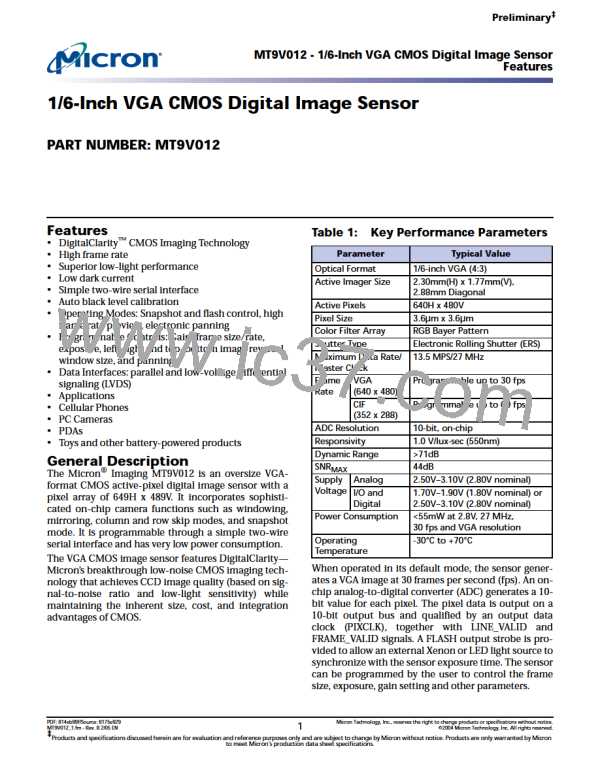‡
Pre lim in a ry
MT9V012 - 1/6-In ch VGA CMOS Dig it a l Im a g e Se n so r
Fe a t u re De scrip t io n
Po w e r Sa vin g Mo d e s
The sensor can be put into a low power standby state by either of these mechanisms:
• Asserting STANDBY (provided that Reg0x0D[7] = 0)
• Setting Reg0x0D[2] = 1 by performing a register write through the serial register inter-
face
The two methods are equivalent and have the same effect:
• The source of standby is synchronized and latched. Once latched, the full standby
sequence is completed even if the source of standby is removed
• The readout of the current row is completed
• Internal clocks are gated off
• The analog signal chain and associated current and voltage sources are placed in a
low-power state
The standby state is maintained for as long as the standby source remains asserted. The
state of the signal interface while in standby state is shown in Table 10.
Ta b le 10: Sig n a l St a t e Du rin g St a n d b y
Sig n a l
St a t e
0
0
0
1
0
0
LINE_VALID
FRAME_VALID
LINE_VALID
PIXCLK
FLASH
DOUT(9:0)
Output enable control can be used to place the signal interface in High-Z (“Output
Enable Control” on page 41).
While in standby, the state of the internal registers is maintained and the sensor contin-
ues to respond to accesses through its serial register interface. An even lower power
standby state can be achieved by stopping the input clock (CLKIN) while in standby. If
the input clock is stopped, the sensor will not respond to accesses through its serial reg-
ister interface.
Exit from standby must be through the same mechanism as entry to standby. When the
standby source is negated:
1. The internal clocks are restarted
2. The analog circuitry is restored to its normal operating state
3. The timing and control circuitry performs a restart, equivalent to writing Reg0x0D[1]
= 1
After this sequence has completed, normal operation is resumed. If the input clock has
been stopped during standby it must be restarted before leaving standby.
When the sensor is configured in serial mode, the LVDS output remains driven when the
sensor is in the standby state.
Flo a t in g In p u t s
Many MT9V012 signals use bidirectional pads. There are three reasons for this:
• The signal associated with the pad is bidirectional in normal use (the only signal in
this category is SDATA)
• The pad is used for output signals in some modes and input signals in other modes
(e.g., LINE_VALID)
PDF: 814eb99f/Source: 8175e929
MT9V012_2.fm - Rev. B 2/05 EN
Micron Technology, Inc., reserves the right to change products or specifications without notice.
42
©2004 Micron Technology, Inc. All rights reserved.

 MICRON [ MICRON TECHNOLOGY ]
MICRON [ MICRON TECHNOLOGY ]